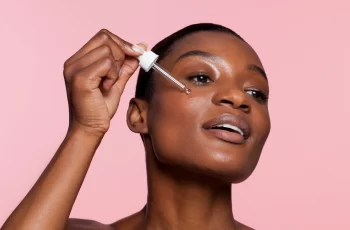(Often Forgotten) Bits Of Your Body That Are Still Prone To Burning
We’ve all done it. Stood in front of the mirror after a long day in the sun and let out an audible sigh/oopsies for the patches of red that have suddenly transpired after that post-beach hot shower.
Whether you inadequately applied sunscreen in the first instance, failed to regularly reapply throughout the day, or straight up ‘forgot’ about those damaging UV rays, here’s a list of the most commonly forgotten bits of your body that are still prone to burning (and so sore when they do get burned).
Scalp
The top of your head, like any other skin on your body, is susceptible to sun damage. If you aren’t wearing a hat, firstly, why not, and secondly, no your luscious locks are not enough to protect your scalp from burning. Take a small amount of face sunscreen and apply it to your hair part, and if you’re bald, just lather that whole noggin of yours.
Ears
Those sticky-outy things on the side of your head, yep thooose. A reminder that your ears are exposed to the sun while walking, driving, sitting by the window desk at work, so start extending that daily sunscreen application all the way to the edges to include ears, jawline, neck, scalp.
Eyelids
Have you been protecting the protective layer of your eyes? Feels novel, but without a wide-brimmed hat, sunglasses and a layer of SPF, you’re practically begging our (bad) friends UVA and UVB to get burning. Our eyelids are really delicate too, so while sunburn in this area is going to sting, we also recommend being gentle with the sunscreen application too.
Lips
For some reason we focus primarily on the cheeks, nose and forehead, forgetting our lips which are actually made of highly sensitive tissue. The skin on our lips is super duper thin, meaning it’s far more delicate than the rest of our bodies, and very susceptible to skin cancer if repeatedly damaged. Time to invest in a good quality SPF lip balm, stat!
Hands
So you put sunscreen on your arms, but did you go all the way down to your fingertips? Don’t lie… The tops of our hands are just as vulnerable to burning as the rest of our long limbs, and they’re typically one of the first areas of the body to show signs of ageing (freckles, sunspots, accentuated veins, wrinkles, sagging skin).
Feet
Your feet don’t see the light of day for months on end (thanks, winter) then suddenly you’re sporting sandals at the office and walking barefoot from the beach to the pub come Saturday. The tops of our feet need a lick of protection too if you want to avoid the whole peeling meets bad-birkenstocks-tan vibe.
Back of the knees
If you’re someone who also screens the top of the leg then the bottom half, portioning out that SPF, you’ll know how easy it is to miss the back of the knees in between. Not to mention this part of our body tends to get quite sweaty so any sunscreen that was applied is likely to be removed and/or rubbed off much quicker. There’s nothing worse than a nasty burn in those bendy creases! Makes walking, working out, sitting at a desk much more uncomfortable. You’ve been warned.
Armpits
You’re laying on your back, a sugary summer romance novel extended above your head, and suddenly those supple armpits of yours are entirely exposed to the sun’s harsh rays. We’ll be the first to admit it’s not yet a habit to apply sunscreen here (we recommend applying before deodorant so your skin has time to absorb the product) but any whiff of a potential sunburn here and we’re scared.
DQH Knowledge drop: In your 20s, your skin cell turnover decreases. (Cell turnover is a key component in keeping your skin youthful.) You know what else slows down? Your collagen production. Starting in your 20s, collagen decreases by about 1 percent per year. Should you want to prevent fine lines and wrinkles, start by eliminating behaviors that contribute to premature aging. “If it’s bad for you, it’s bad for your skin,” says dermatologist Michel Somenek.
“Cigarette smoking reduces blood flow to the skin and causes premature wrinkling and a dull skin texture. Making the repeated pursed motion to inhale can also cause smoker’s lines. Alcohol and recreational drugs are toxins for the skin that damage its cellular structure and DNA,” Somenek tells us. “The faster you eliminate vices while you are young, the better chance your skin and body have to recuperate.” Also, adopting an anti-aging routine in your 20s is key. After all, the best offense is a good defense. We spoke to Somenek and experts Joshua Ross and Audrey Kunin to find out more.
Keep reading for the best anti-aging products for your 20s, according to skincare professionals.
Sunscreen
“We all know that the sun is the number one cause of skin aging and starting the prevention in your 20s is very important,” Ross says. “The majority of your sun damage won’t start to appear until you’re in your 30s, so don’t wait until you see it surface or you’ll be behind the curve. Stay ahead of it with a good-quality zinc-based sunscreen worn daily.”
Farmacy Green Defense Daily Mineral Sunscreen
An invisible sunscreen with SPF 30, plus botanical extracts meant to protect skin with tons of antioxidants. Bonus: It’s clean and fine to use under makeup.
Bareminerals Complexion Rescue™ Tinted Moisturizer Broad Spectrum SPF 30
Although we recommend you use your SPF and moisturizer separately, we also understand moments when you don’t have time or energy for that extra step. For those times, this bareMinerals moisturizer is a great thing to have on hand.
Vitamin C Serum
“A great introduction to anti-aging is to start with a vitamin C serum in your morning skincare routine,” Ross says. “It’s a powerful antioxidant that will neutralize free radicals and brighten the skin.” He adds that it’s a great way to counteract the effects of the sun’s harmful rays, which, as previously mentioned, are among the biggest causes of premature aging.
Drunk Elephant C-Firma™ Vitamin C Day Serum
The Drunk Elephant C-Firma is a lightweight serum that promises to give skin a glow by combining the brightening powers of vitamin C with ferulic acid, l-ascorbic acid, and vitamin E. The included sodium hyaluronate is meant to replace hydration loss, so you shouldn’t have to deal with any irritation.
Sunday Riley C.E.O. Rapid Flash Brightening Serum
This potent serum is jam-packed with vitamin C (15 percent, to be exact), which means it’s a potential superstar at both brightening skin and dousing it in antioxidants.
Peptides
Using peptides on your skin has many benefits, says Somenek. “The skin barrier is what defends the body against pollution, UV rays, bacteria, and toxins. It can be damaged by several everyday factors. Using topical peptides aids in building a stronger barrier,” he says. “Peptides comprise elastic fibers, which are a type of protein. These fibers help to make skin appear taut and firm. Peptides can also help repair damaged skin, relieve inflammation, and even out skin tone. Some peptides can kill acne-causing bacteria that is common in 20-somethings.”
Kunin agrees, saying, “Peptides are an excellent entry point for supporting collagen.” She recommends looking for face and eye treatments that contain these collagen-boosting powerhouses.
Charlotte Tilbury Magic Eye Rescue Cream
This Charlotte Tilbury super-emollient eye cream has a base of coconut oil and shea butter (read: it’s incredibly hydrating). Botanicals plus peptides are meant to help reduce dark circles and boost collagen, respectively.
This creamy moisturizer serves up potent collagen-boosting peptides and pycnogenol, and antioxidant-rich vitamin C. “Instead of sitting on top of the skin, peptides penetrate the outer layer so they go deep. The ‘signals’ they send tell the cells to produce elastin and collagen, which are needed for youthful-looking skin,” explains Somenek.
At-Home Peel Pads
Remember that skin cell turnover fiasco we talked about earlier? One way to help support it is by exfoliating. “Exfoliation is important to help keep skin fresh and luminous,” Kunin says. She recommends using at-home peel pads as an easy and effective way to exfoliate.
“The goal in your 20s is to fight the slowing pace of cell turnover. It is wise to use products that gently exfoliate, yet still remove oil and other impurities. Products that have Alpha Hydroxy Acids (AHA) or Beta Hydroxy Acids (BHA) are a good choice.”
According to Somenek, you should only exfoliate two to three times a week. “People of all ages are guilty of over-exfoliating and that can be too much of a good thing,” he says.
Dermadoctor Kakadu C Intensive Vitamin C Peel Pad
A few swipes of this Derma Doctor powerful peel pad promise to leave your skin glowing and smooth, thanks to the seven (yes, seven) types of chemical exfoliants, including AHA and BHA. It also contains vitamin C via Kakadu plum extract for added brightening and antioxidant protection.
KEY INGREDIENTS Kakadu plum extract is sourced from the Kakadu plum, a fruit grown in northern Australia. It contains vitamin C, which restores the skin’s natural barrier, increases collagen production, and soothes irritation.
Dr. Dennis Gross Skincare Alpha Beta® Universal Daily Peel Pads
These are the gold standard of peel pads, with a cult following and over 900 five-star reviews on Sephora. They’re easy to use and contain a blend of anti-aging exfoliating acids.
Emollient Night Cream
“In your 20s, you need to start upping the hydration in your skincare routine. You may have been cautious of over-moisturizing because of acne in your teens, but as you enter your 20s, your skin transitions and becomes drier,” Ross says. “I recommend an emollient night cream added into your evening skincare regimen.”
“Twenty-somethings need to make sure that they are not using creams that will clog their pores and cause excess oil production,” says Somenek. Opt for non-comedogenic products.
Cerave Skin Renewing Night Cream
One great choice is the CeraVe Skin Renewing Night Cream, which is a non-comedogenic night cream that leaves skin soft and glowy. It combines the moisturizing powers of ceramides and hyaluronic acid.
RoC Retinol Correxion Max Hydration Creme
“The best night cream ingredients contain retinol, benzoyl peroxide, and/or salicylic acid or hyaluronic acid. The goal is to moisturize, yet remove excess oil,” says Somenek. This Roc Retinol Correxion cream fits the bill as it contains both hyaluronic acid and retinol so it promises to moisturize while also being non-comedogenic.



